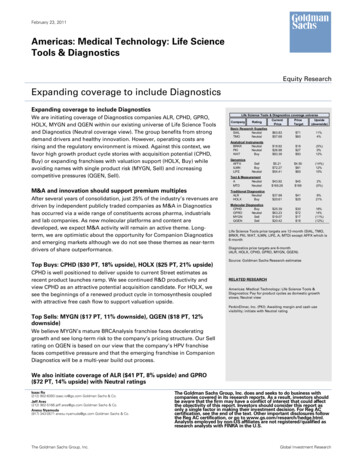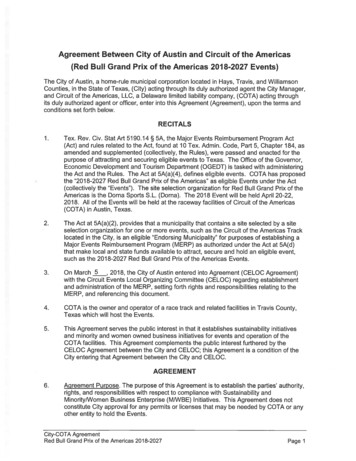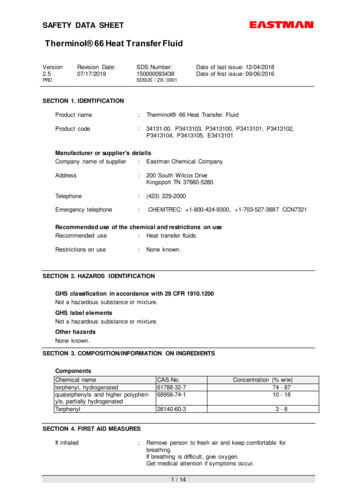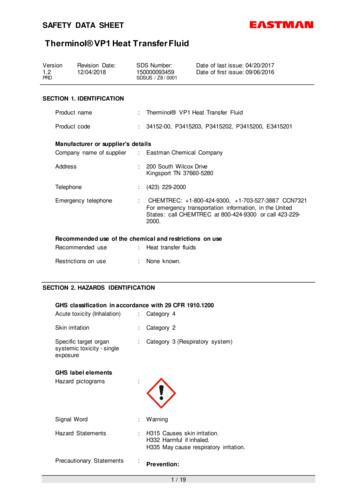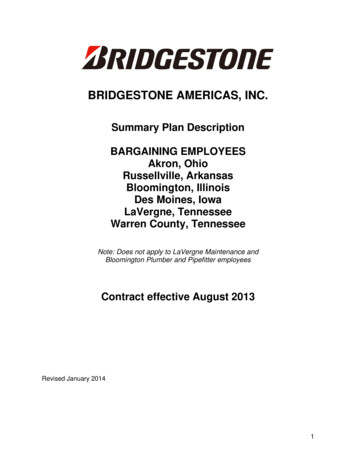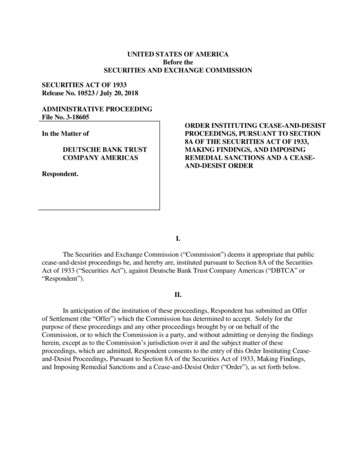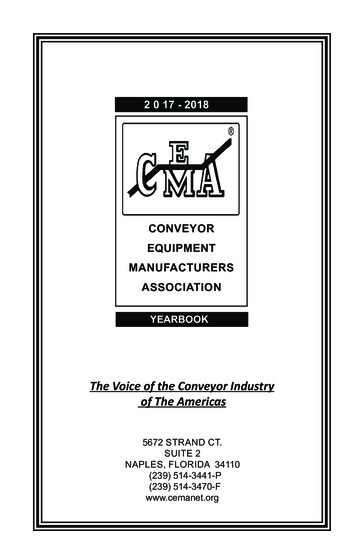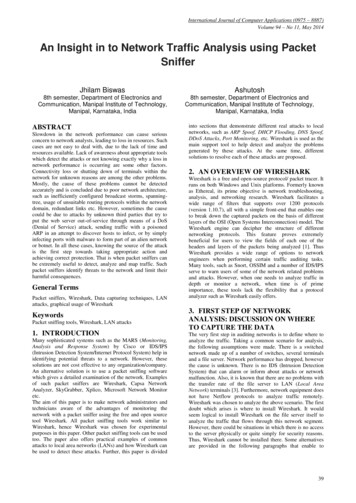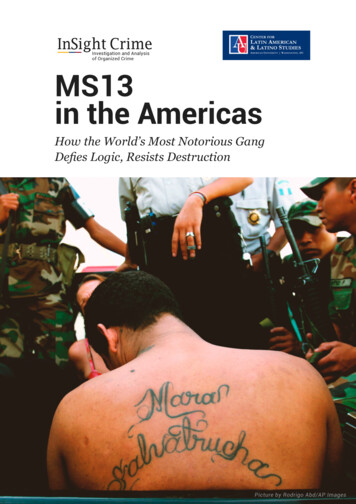
Transcription
MS13in the AmericasHow the World’s Most Notorious GangDefies Logic, Resists DestructionPicture by Rodrigo Abd/AP Images
MS13 in the AmericasTable of ContentsMajor Findings .3Introduction .7Methodology .10MS13: A Brief History.13From Stoners to Deportees.13La eMe and the MS13 .16From El Salvador to the East Coast.17From Gang Truce to War.18Philosophy, Ideology and Guidelines .22Philosophy: El Barrio and Las Letras .22The Ideology of the Other.24MS13 Guidelines .25Organizational Structure.29Cliques .29Programs and Ruling Councils .31Modus Operandi.34Recruitment .34Joining the Gang.35Day-to-Day in the MS13.37Criminal Economy.39Use of Violence.47Social and Political Capital.49Case Studies: The Dichotomies of the MS13.51MS13: Hierarchy vs. Federation .51Violence: Method or Madness? .54Criminal Migration: Master Plan vs. Opportunism.58International Drug Trafficking: Gang Project vs. Entrepreneurism.62Gang Truce: Social vs. Criminal Capital.66Policy Recommendations.71Annex I: The Problem With Counting the MS13.74Annex II: Glossary.77Works Cited .80Investigative Team.88Organizations .89
Major FindingsPicture by Luis Romero/AP ImagesThe Mara Salvatrucha (MS13) is one of the world’s largest and arguably mostviolent street gangs. After relatively humble beginnings in Los Angeles in the 1980s,it has spread to more than a half-dozen countries and become a central focus oflaw enforcement in two hemispheres. In spite of these efforts, the MS13 remains apersistent threat and shows signs of expanding its criminal portfolio. This reportattempts to explain what makes the MS13 such a difficult problem for authoritiesto tackle. It focuses on assisting law enforcement’s understanding of the gang’scriminal activities, but it includes deep discussion on the social and political issuesaround the MS13. Below are our major findings.The MS13 is a largely urban phenomenon that has cells operating intwo continents. The MS13 has between 50,000 and 70,000 members whoare concentrated in mostly urban areas in Central America or locations outsidethe region where there is a large Central American diaspora. In Honduras andGuatemala, the gang is still largely urban. In El Salvador, however, the gang hassteadily spread into more rural areas. Expansion beyond urban areas has alsohappened in places in the United States, most notably in Long Island and NorthCarolina, and increasingly California. The gang has appeared as well in Europe,specifically in urban areas of Spain and Italy. The size of the gang in these settingsvaries greatly and fluctuates, mostly in accordance with law enforcement effortsand migration patterns unrelated to the gang.The MS13 is a social organization first, and a criminal organizationsecond. The MS13 is a complex phenomenon. The gang is not about generatingrevenue as much as it is about creating a collective identity that is constructed andreinforced by shared, often criminal experiences, especially acts of violence andexpressions of social control. The MS13 draws on a mythic notion of community,InSight Crime and CLALS / MS13 in the Americas3
a team concept, and an ideology based on its bloody fight with its chief rival,the Barrio 18 (18th Street) gang, to sustain a huge, loosely organized social andcriminal organization.The MS13 is a diffuse organization of sub-parts, with no single leaderor leadership structure that directs the entire gang. The MS13 has twopoles of power: in Los Angeles, where it was founded, and in El Salvador, itsspiritual birthplace where many of its historic leaders reside. But the gang has nosingle leader or leadership council. Instead it is a federation with layers of leaderswho interact, obey and react to each other at different moments depending oncircumstances. In general terms, most decisions are made by the individual cell,or what is known as the “clica,” the Spanish term for clique. The highest-rankingmembers in some geographic areas make up a leadership council, but not allareas have a leadership council. In Los Angeles, the MS13 is subservient to theprison gang known as the Mexican Mafia. In El Salvador, the gang is also runfrom prison by its own leadership council. Along the East Coast of the UnitedStates, the gang has no council, although it is takes much of its directives fromSalvadoran-based gang leaders. Because these leaders are mostly in jail, it isexceedingly difficult for them to impose total control over the rank-and-file.The MS13 has guidelines more than rules, which are subject to varyinginterpretations. The diffuse nature of the organization has widespreadimplications for how it operates. The gang has guidelines more than rules. Theseguidelines are subject to haphazard interpretations and application. In otherwords, this internal justice is not necessarily a strict system and often dependsmore on who the leader is and who is being judged, rather the actual transgressionor the circumstances surrounding it. This inconsistent application of the rulesleads to constant internal and external conflicts and is the cause of widespreadviolence wherever the gang operates.MS13 violence is brutal and purposeful. Violence is at the heart of the MS13and is what has made it a target of law enforcement in the United States, CentralAmerica and beyond. It is central to the MS13’s ethos, its modus operandi, andits evaluation and discipline of its own members. Violence also builds cohesionand comradery within the gang’s cliques. This use of violence has enhanced theMS13’s brand name, allowing it to expand in size and geographic reach, but ithas undermined its ability to enter more sophisticated, money-making criminaleconomies. Potential partners see the gang as an unreliable, highly visible target,and the gang’s violent spasms only reinforce this notion.The MS13’s diffuse nature makes it hard for it to control its ownexpressions of violence. The MS13’s diffuse nature has made it difficult tocurtail its violence. The gang itself has attempted to implement rules to controlthe use of force. Most murders must be sanctioned from the highest levels, butas one of our case studies illustrates, this is often a perfunctory task, reflectingwhat seems to be a disregard for human life. In addition, the very system thatInSight Crime and CLALS / MS13 in the Americas4
is designed to control the violence often leads to more violence, since failure tocarry out a sanctioned hit becomes cause for internal disciplinary action.The MS13 is a hand-to-mouth criminal organization that dependson control of territory to secure revenue. The gang’s lack of a centralizedleadership has kept it relatively impoverished. While it has established revenuestreams, the MS13 has a hand-to-mouth criminal portfolio. Extortion is thesingle most important revenue stream for the gang in Central America, althougha significant and rising portion of the MS13’s criminal portfolio comes fromlocal drug peddling, especially in US cities such as Los Angeles. The gang isalso involved in prostitution, human smuggling, car theft and resale and othercriminal activities, but the gang’s revenue nearly always depends on its ability tocontrol territory.The MS13 is a transnational gang, not a transnational criminalorganization (TCO). While the gang has a presence in two continents andat least a half-dozen nations, the gang is a small, part-time role player ininternational criminal schemes. In cases of international drug trafficking, forinstance, the MS13 is dependent on other criminal actors such as the MexicanMafia. The gang plays a similar, part-time role in other international criminalactivities such human smuggling as well. Its diffuse organizational structure andpublic displays of violence are two of the main reasons why the gang has notsucceeded in transforming itself into a TCO. And while some criminal activity –most notably the MS13’s involvement in petty drug dealing on a local level – isdriving the gang’s maturation process and leading it to new opportunities, this isa slow process that is causing significant conflict within the gang.El Salvador’s MS13 leaders are trying to assert more control over theUS East Coast. Some MS13 leaders, especially those operating from jails inEl Salvador, are trying to create more top-down control, and expand its socialand political influence. In El Salvador, the gang has negotiated delivering votesto some of the country’s most powerful politicians. They have also institutedmore formal and complex command structures inside and outside of jail, andthey have emissaries in places as far away as Boston who are trying to corral therudimentary and undisciplined gang cliques operating along the US East Coast.The MS13 is taking advantage of traditional migration patterns, notsending members to set up new cells. The MS13’s efforts in El Salvadorhave alarmed law enforcement officials who say the gang’s high-ranking leadersare also moving their rank-and-file around the region, including to the UnitedStates. But while the gang is repopulating cells and establishing new ones, theMS13 appears to be taking advantage of circumstances, rather than activelycreating those circumstances. MS13 members migrate for the same reasons thatother migrants do, and they go to the same places. They also face many of thesame risks such as indigence, isolation, victimization, detention and deportation.InSight Crime and CLALS / MS13 in the Americas5
This report is divided into five sections. We begin by chronicling the multi-nationalhistory of the MS13. The group is the byproduct of war, migration and policy, andit has a footprint in a half dozen nations. We then turn to the gang’s philosophy,its guiding principles and ideology. The gang centers itself around the idea ofcommunity, which is reinforced mostly via violent rituals and expressions of ragetowards outsiders and rivals.From there, we move to organizational structure. This includes explaining thelargely misunderstood loose hierarchy of the gang and its clique system. Then wecover modus operandi, tackling the all-important questions of recruitment, criminaleconomy, use of violence, and political and social capital. Finally, we elaboratefive case studies, which address the MS13’s: 1) organizational structure; 2) use ofviolence; 3) criminal migration; 4) involvement in international drug trafficking; and5) political and social capital.InSight Crime and CLALS / MS13 in the Americas6
IntroductionPicture by Pablo Martinez Monsivais/AP ImagesO n July 28, 2017, President Donald Trump traveled to Brentwood, Long Island.The area had seen an uptick in violence related to the MS13. In April, four teenagershad been brutally murdered in nearby Central Islip. In September, 2016, two teenagegirls had been killed in Brentwood. They were just part of a string of 17 murdersprosecutors blamed on the Mara Salvatrucha, or MS13, in the previous 18 months.“They kidnap, they extort, they rape and they rob,” Trump said of the gang. “Theyprey on children. They shouldn’t be here. They stomp on their victims, they beatthem with clubs, they slash them with machetes, and they stab them with knives.They have transformed peaceful parks and beautiful quiet neighborhoods into bloodstained killing fields. They’re animals.” (Associated Press and CBS News, 2017)The MS13 is one of the largest gangs in the world. Operating in more than a halfdozen countries across two continents, the gang has thousands of members that haveformed a loosely knit criminal and social federation with a powerful brand name. AsTrump noted, the gang is known for its violence. It is responsible for thousands ofhomicides per year, many of them committed against its own members. Its brutalityhas become its hallmark, leaving hacked and dismembered bodies in public parks,rivers and ditches.The gang’s violent activities have also become the focus of special gang units andinter-agency task forces across the United States. The Department of HomelandSecurity (DHS) is targeting its members to find and deport violent undocumentedmigrants. The Drug Enforcement Administration (DEA) is trying to undermine theMS13’s attempts to break into transnational criminal drug market. And in El Salvador,Honduras and Guatemala, the gang is the perennial focus of law enforcement andprosecutors.InSight Crime and CLALS / MS13 in the Americas7
Gang-related murders are thought to represent around 13 percent of all homicidesin the United States (National Gang Center, 2012), and upwards of 40 percent of thehomicides in El Salvador, Honduras and Guatemala. There are no empirical studiesstrictly concerning MS13-related violence, and quantifying its offenses lies beyondthe scope of this investigation, but in the areas we studied for this report, the MS13was uniformly seen by law enforcement and civil society experts as the most, orone of the most, violent gangs. The numerous federal and local murder cases wouldappear to at least partially confirm this perception.The MS13 is as violent with its own members as it is towards its rivals and anyonewho is perceived to cross the gang, including innocent bystanders. In the UnitedStates, this violence seems to come in waves. For example, in Suffolk County, LongIsland, authorities blame the gang for 17 of the 45 murders in the county betweenJanuary 2016 and May 2017. (Sini, 2017) Law enforcement gang experts in the LosAngeles area offer similar if not so specific estimates. Even where the gang has lessof a role in homicides, such as the Greater Washington, DC area, the murders theydo commit are notable for its brutal, macabre nature. (Montgomery County, 2017)In Central America, violence is more acute and widespread, so tracking these patternsas they relate specifically to the MS13 is more difficult. While gang-related homicidesare believed to represent a sizeable portion of the murders in El Salvador, Guatemalaand Honduras, there is little reliable empirical information to prove this theory.(Dudley S. , Homicides in Guatemala, 2017) The one data point we do have cameduring the gang truce in El Salvador from 2012 to 2013, when homicides dropped byhalf after the MS13 and the Barrio 18 entered a temporary cease fire. (Gurney, 2015)For the Trump administration, the MS13 is particularly important. The JusticeDepartment has made the gang a top priority, and a series of indictments in themurder cases in Long Island and elsewhere show that it is putting law enforcementresources towards this end. Trump has also used the gang for political purposes,conflating the dangers of undocumented migrants in the United States with gangviolence in order to further his anti-immigration agenda.For some, the MS13 is a transnational criminalorganization, capable of orchestrating cross-borderassassinations and trafficking illicit drugs. For others,it is a dangerous but predictable response to abuseand social marginalization.“I have a simple message for every gang member and criminal alien that arethreatening so violently our people: We will find you, we will arrest you, we will jailyou and we will deport you,” Trump said in his July speech in Brentwood.InSight Crime and CLALS / MS13 in the Americas8
Still, despite the prosecutions and the rhetoric, there is little to suggest that theTrump administration’s response to the gang will yield better results than whathas already been tried. Since emerging in the streets near downtown Los Angelesin the early 1980s, the MS13 has vexed authorities and resisted efforts to destroyit. It has persisted for almost four decades without a master plan, an all powerfulleader or a reliable source of income. Its core membership consists of teenagerswho communicate mostly via text messages. Its principal communications strategyis conveyed with spray paint. Its leaders are in jail. Most of its members did notcomplete high school. (Cruz, 2017)Yet the MS13 remains strong, some would say thriving. It is experiencing a resurgencein areas along the US East Coast, and establishing new beachheads in ruralCalifornia and cities in Europe. (Alonso, 2016) It is also reorganizing, establishingclear hierarchies and lines of discipline in an effort to professionalize and enternew criminal markets. All of this while it faces down fierce government efforts todismantle it in the United States, Guatemala, Honduras, El Salvador, Italy (Valencia,2016) and Spain. (Roberts, 2014)The gang is a study in contrasts; a violent criminal group, to be sure, but also partsocial and part political. It is a group that can fill basic human needs just as easilyas it can end a human life. It can move drugs over international borders, but it hasa difficult time paying its members a living wage. These divergent characteristicsexplain contradictory assessments of the gang by law enforcement and gangresearchers alike. For some, it is a transnational criminal organization, capable oforchestrating cross-border assassinations and trafficking illicit drugs. For others, itis a dangerous but predictable response to abuse and social marginalization. As weshall see, the gang encompasses elements of all of the above and more, which is whyit has become so difficult to eradicate.This report focuses on the criminal enterprises the MS1
organization (TCO). While the gang has a presence in two continents and at least a half-dozen nations, the gang is a small, part-time role player in international criminal schemes. In cases of international drug trafficking, for instance, the MS13 is depe

